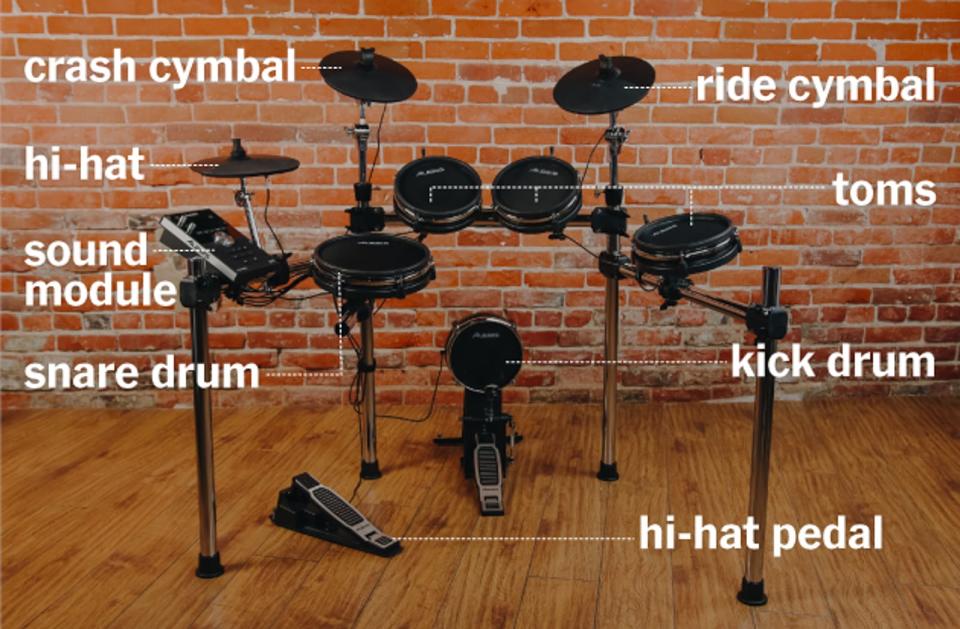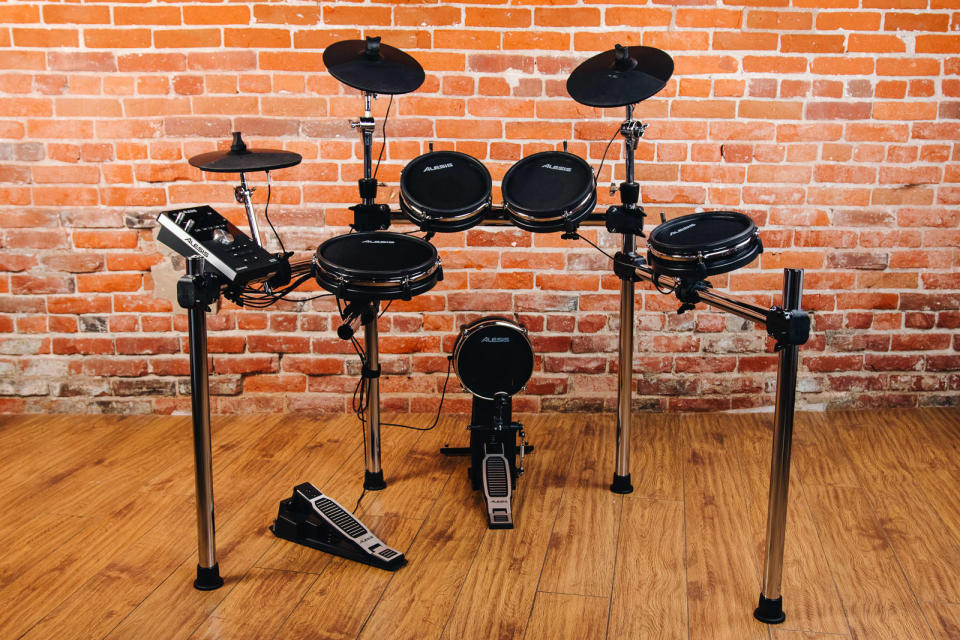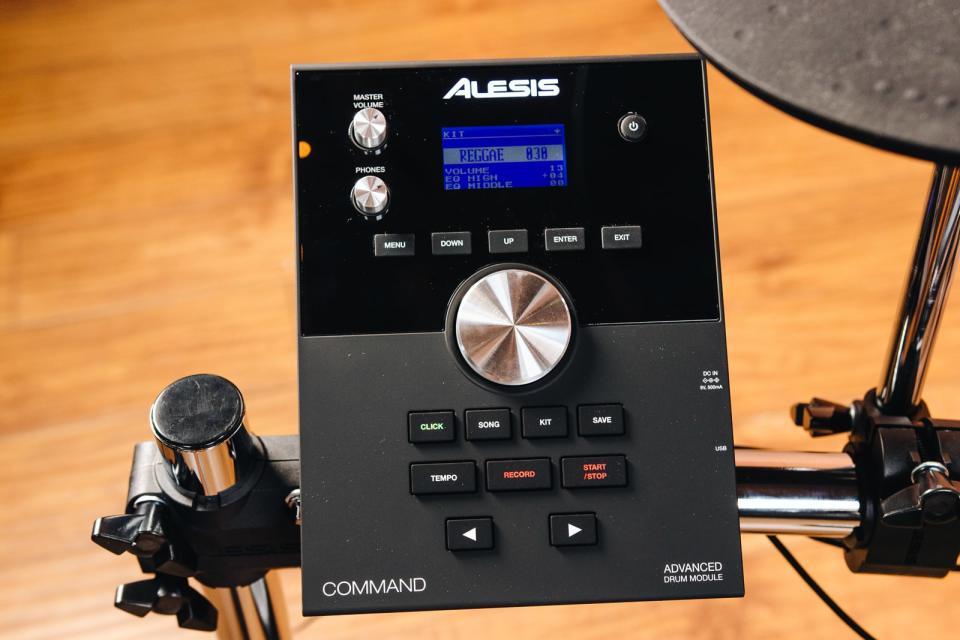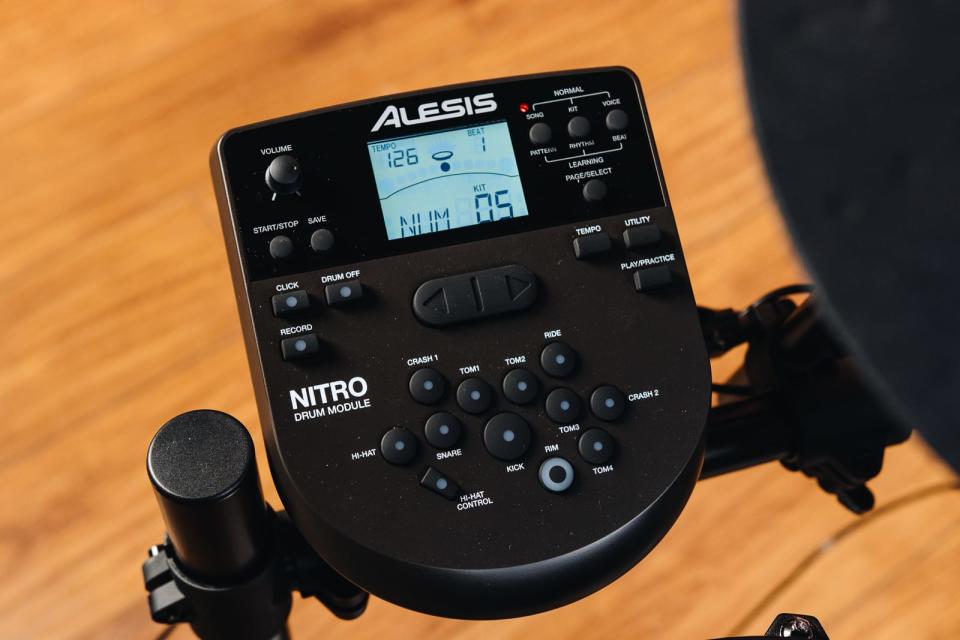The best electronic drums for beginners
They'll be gentler on the ears than an acoustic set.
By Brent Butterworth
This post was done in partnership with Wirecutter. When readers choose to buy Wirecutter's independently chosen editorial picks, Wirecutter and Engadget may earn affiliate commission. Read the full guide to electronic drums for beginners.
It's every parent's nightmare: Your child wants to take up the drums. Practicing on acoustic drums makes a household feel as cozy as a construction site, but electronic drums produce little sound of their own, so they're great for beginning (and returning) drummers. We tested five kits and found that the Simmons SD600 provides the best blend of comfort, sturdiness, flexibility, and affordability.
The Simmons SD600 is an affordable, sturdy electronic drum set that plays great and is easy to set up and adjust. Its mesh drum heads and larger ride cymbal make it feel a little more like a real drum kit. It offers 35 different simulated kits, including classic rock, hip-hop, country, jazz, and more. A few of them don't sound as realistic or detailed as we'd like, but the SD600 offers an unusually diverse array of sounds, and you can easily modify the simulated kits and sounds through an iOS app.
The Alesis Command Mesh is a big, sturdy set that's easy to adjust to fit any drummer. Its mesh heads feel great, particularly the 10-inch snare drum. The large sound module is simple to use and includes a huge array of drum sounds with 54 simulated kits—some of which will likely be more useful than the novelty sounds included in many e-drum kits. But the Command Mesh is one of the most expensive kits we tested.
The Alesis Nitro Mesh is something of a minor miracle—a very affordable kit that gives beginning drummers everything they need and nothing they don't. It's smaller than the other kits we tested, so it may be a tight fit for large adults. It also may not be sturdy enough to tolerate the pummelling that a skilled drummer may produce. But for the grade-schooler or teenager who wants to try out drumming, it's an ideal choice.
Why you should trust us
I've been playing music since I got my first ukulele back in 1969, and I later played snare drum in the school band. I don't play drums now, but as a bassist, I've played with and recorded lots of drummers in jazz and rock gigs in Los Angeles and New York City. I own a drum kit and many percussion instruments (including electronic drum pads) that visiting musicians use for rehearsals in my home music studio, so I understand the instrument well.
Wirecutter musical instrument editor Geoffrey Morrison has a degree in audio production from Ithaca College, and he does some music performance and recording as a hobby.
To guide us in setting up this project, choosing the kits to test, figuring out what a beginning drummer wants and needs in a kit, and assembling a panel of drum testers, we recruited Danny Beallo, who teaches drums at Culver City High School in Los Angeles and plays in several bands in Los Angeles. Beallo owns an electronic drum kit and several acoustic kits, and he plays a wide variety of musical styles.
To provide a second opinion from the instructor's point of view, Beallo brought along Azuri Zen Moon, a Los Angeles musician who teaches drums, guitar, and piano privately and plays with Beallo in the band Ship of the Rising Sun.
We also wanted to get the perspective of a couple different kinds of students: a young student just starting out as well as someone who wants to take up drums again after a long hiatus but doesn't want to disrupt their family with loud crashes and rolls. For the first perspective, we got Wesley Page, a student of Beallo's who actually started on an electronic kit because his drummer father's kit was too big for him. For the latter perspective, we got Mike Wood, who has worked for many years as a journalist, product specialist, and PR rep in the audio/video industry. Wood played in rock bands in his college years and has been thinking about taking up the hobby again now that his career is established and his kids are older.
Who should get this
Because electronic drum kits make very little noise on their own, they're perfect for beginning drum students and drummers who don't want to disturb their family members when they practice. The drummer usually listens through headphones, although the kit can be plugged into a drum amp or a P.A. system for playing along with other musicians. The affordable models we feature here are intended for practicing rather than live performance because they're not built tough enough to survive repeated disassembly, reassembly, and transportation.
Another huge advantage of electronic drum kits for beginners is that they include almost everything you need: a snare drum, tom-toms in three sizes, a kick (bass) drum, a hi-hat, and crash and ride cymbals (see photo below). All you need to add is a drum throne (or stool) and headphones. Most acoustic drum kits must be assembled piecemeal, requiring separate purchases of drums, cymbals, stands, and other hardware—a process that can be intimidating and can easily cost twice the price of a good, inexpensive electronic drum kit.

Because they generate sounds digitally rather than acoustically, electronic drums can simulate the sounds of many types of drum kits—such as rock, funk, latin, or jazz, or percussion instruments of India, China, and so on—and thus allow the beginner to experiment with all sorts of sounds and genres.
Many serious drummers own an electronic kit for quiet practicing, but we don't focus on them here because we figure active musicians already know best what will work for them.
Note that while there are ways to make acoustic kits quieter, they often cost as much as a starter electronic kit, and none preserve the sound of the acoustic drum kit.
How we picked
After playing several electronic drum kits in stores and at the 2019 NAMM show, we settled on the following criteria for picking the drum kits we would test:
Feel: Some electronic drum kits, especially many models priced below $500, have such a different design and feel from an acoustic drum kit that they seem like a different (and less rewarding) instrument. The newer mesh drum heads, which use a tensioned mesh material instead of rubber-covered pads, provide a look and feel that's closer to acoustic drums (their head tension can even be adjusted like those on acoustic drums), so we gravitated toward these. The only exception was Yamaha, which didn't offer a mesh-head kit in our price range; we chose to still include Yamaha kits based on their reputation and a demo of their instructional app.
Price: We decided to test kits priced between $300 and $700. All of the under-$300 kits we tried felt more like toys than instruments, and the more-than-$700 kits add features that a beginning (or returning) drum student isn't likely to need, such as extra cymbals and pro-quality hardware designed for live performance.
Build quality: We wanted kits with reasonably sturdy racks that won't allow the various components to move around much and that won't force the student to constantly re-adjust the positioning of the drums.
We ended up with five drum kits. We would have liked to test more, but some manufacturers are still in the process of transitioning to mesh heads, and some new models that have been announced (or mentioned to us confidentially) were not yet available at the time of our testing.
Incidentally, none of these kits can be set up easily for left-handed players because the cables aren't long enough. One of our testers, Wesley Page, is left-handed, but he plays a standard right-handed setup. "I think it's better," he explained. "If you have a gig where there's already a drum kit set up, you might have only a few minutes to shift it around for left-handed playing."
How we tested

I set up all the drum kits in Wirecutter's Los Angeles facility, noting which were the easiest to set up and which were the most complicated. I then invited the drummers to play the kits. While it wasn't practical to obscure the brand names (they're printed on all the drum heads), I didn't inform the panelists of the prices until after they'd given me their opinions.
Each tester used their own sticks. While some of the kits include a cheap set of sticks, the instructors stressed that every student should go to a music store and pick out their own sticks with the help of the salesperson in the drum department. (Don't do as I did and simply buy your drum hero's signature sticks—I was crushed when the instructors informed me that the Elvin Jones Promark sticks I'd been using were way too light for me.) I had a few different sets of professional headphones on hand for the tests, and I asked the drummers to pick a set of headphones and use the same set to evaluate all the kits.
I asked all the testers to judge each drum kit based on the criteria they considered most important for our two target students: a young beginner and someone returning to the hobby. As I spoke with them afterward, I found that the criteria the drummers considered most important were:
How closely a kit approximated the feel of an acoustic kit
How easy it was to adjust the kit to suit the drummer
How sturdy the kit was
How convenient the controls and jacks were on the sound module
The quality and versatility of the drum sounds
Note that none of these kits feels like a replacement for an acoustic kit. While all the electronic drums and cymbals we tested play louder when you hit them harder, they sound basically the same no matter how you hit them. The simulated hi-hats, in particular, were criticized because the pedal tended to have an "on/off" quality, rather than allowing the two cymbals in the hi-hat to hang partially open, as is possible with more expensive, two-cymbal electronic hi-hats.
Likewise, much of advanced drum-kit technique involves the snare drum, but none of these kits provided a rich palette of snare sounds. Only one kit included a ride cymbal that could produce different sounds when played on the edge, the bell (the raised part in the center), or the bow (the part of the cymbal between the bell and the edge).
All of these kits do provide a number of advanced features, including tempo-adjustable songs for play-along practice; a line input for connecting a phone or tablet to play along with recordings; a built-in metronome; and the ability to record performances. In addition, Roland, Simmons, and Yamaha offer instructional apps with exercises that help you gauge your accuracy and timing. While all of our testers experimented with these features, none considered any of their inclusion to be a huge plus or their omission to be a huge minus.
Although all of these kits let the drummer adjust such parameters as the sensitivity of the triggers (to lessen the likelihood of triggering other drums in addition to the one you hit), none of the drummers we brought in felt the need to make such adjustments; all the kits seemed pretty well dialed-in right out of the box.
Our pick: Simmons SD600

The Simmons SD600 emerged as the best choice for a typical student drummer. It was the top pick of both instructors, and both of our students liked it. Everyone praised its sturdy construction and considered its mesh heads to be a reasonable simulation of the real thing. Contributing to that realism is that the SD600 has a relatively large snare (10 inches) and is the only kit we tested with a larger ride cymbal (12 inches). It's easy to adjust to fit any drummer, and it offers a huge palette of sounds, although some of them don't sound as realistic as we would like. The SD600 was among the easiest to set up because the rack is already fully assembled; you just attach the drums and cymbals and connect the wires. I didn't even need the manual.

"It's sturdy, the heads feel good, and there's a nice variety of sounds," Beallo said. "Even if you upgrade to an acoustic kit in a year or two, you'd still want to keep this one." Wood added, "This one has the most drumlike feel to me."
Another significant plus is the large, friendly sound module, with large buttons and an alphanumeric display to make operation easier. The SD600 is the only kit we tested that provides a Bluetooth connection to smartphones and tablets. While this allows interfacing with music production apps such as GarageBand, the main purpose is to connect to the Simmons iOS app, which provides more play-along tunes and easier adjustment of the drum sounds. Our panelists didn't think these features were all that important, but they did love the included phone/tablet rest atop the sound module, which would come in handy for play-alongs.
This kit lets the drummer choose from among 35 different simulated kits and create 10 custom kits. Only three play-along songs are available on the sound module, but six more are available through the app.
The SD600 was one of only two kits that we tested to offer two-zone toms, which produce different sounds when you hit the drum head and the rim. For the most part, our drum testers thought this feature was a little gimmicky, but it might provide some fun for beginners. Page noted that some of the SD600's simulated kits offer a splash cymbal sound on one of the tom rims, mimicking the effect of the small cymbal that some drummers use just above their toms. For a more amusing (although likely less useful) example, the India kit offers the sound of a tanpura on the rim of the simulated floor tom at far right.
Overall, the SD600 offers a great mix of comfort, adjustability, realistic feel, and sound options at a reasonable price.
Flaws but not dealbreakers
The SD600's conventional drum kit sounds aren't quite as realistic and detailed as some of the sounds we heard from the Roland and Yamaha kits, but none of the testers considered this a major flaw.
Wood and Page both complained that the ride cymbal, while larger, isn't a two-zone or three-zone design, which would allow the drummer to get some of the distinctly different sounds that a real cymbal offers. (This was the case with all our top picks.) On a real ride cymbal, drummers can switch back and forth from tapping on the box of the cymbal for a warmer sound, the bell for a brighter sound, or the edge for a crashing sound. With the SD600, the crash cymbal can be choked (stopped from ringing by grabbing it with your hand), but the ride cymbal can't; our instructor panelists pointed out that by the time students want to practice a more advanced technique such as cymbal choking, they'll probably move on to a kit with real cymbals.
Upgrade pick: Alesis Command Mesh

We liked the Alesis Command Mesh for all the same reasons we liked our top pick, the Simmons SD600. It's big, sturdy, and easily adjusted to fit any drummer. It was the top pick of both students; the instructors liked it, too. It's sturdier than the SD600, offers a lot more sounds, and comes with many more play-along tunes built in. For rock drummers who need a more rugged kit or any drummer who wants more creative options, it's worth the extra cost.
Like the SD600, the Command Mesh has a 10-inch snare, a solidly built rack, and two-zone toms, and it captures much of the feel of real drums. Wood also commented that the hi-hat gave him the best response of any of the electronic kits.

While both cymbals can be choked—stopped from ringing by grabbing them with your hand—they're the same simple, single-zone type found on our other picks, so you can't get different sounds by hitting them in different places.
The Command Mesh gives you a few nice extras that you don't get with the lower-priced SD600. It has a whopping 54 different simulated kits, as well as memory for 20 user-defined custom kits. With the two-zone toms, that translates into a lot of sonic possibilities. You can even load your own sounds into the Command Mesh via USB stick. The large, easy-to-operate sound module provides 60 play-along tunes.
If you're looking for creative options, the Command Mesh should make you very happy. Besides the usual simulated kits, we especially enjoyed the Orchestra kit, which gives you timpani sounds on the toms and a big orchestral bass drum for the kick, and Marimba, which assigns a different marimba note to every drum and cymbal. Most drummers probably won't mess much with these, but they might help keep beginners interested.
The Command Mesh does have a couple of downsides relative to the Simmons SD600. It lacks the SD600's larger ride cymbal, and it doesn't have the control app or Bluetooth interface. Most important, though, it's more expensive—but it's a great choice if you want something that's a bit of a step up from the Simmons SD600 or if the SD600 goes out of stock.
Budget pick: Alesis Nitro Mesh

All six people who tried these sets (the four drummers, plus me and editor Geoff Morrison) thought the Alesis Nitro Mesh was the obvious best choice if you're looking to save some money—especially if the kit is intended for a tween or teenager, since it is a smaller set. "It'll let you get your chops going, and if you stick with it a year or two, your parents can then get you an acoustic kit," Page said. All of the drummers felt the Nitro Mesh's heads were among the best when it came to delivering a realistic feel.

The Nitro Mesh is smaller than all the other sets we tried. All of our drummers were able to play it and adjust it to their liking, but none of them ever felt entirely comfortable with it. The snare is only 8 inches in diameter, and the rims of the snare and toms are unusually high (almost ¾ inch, compared to about ½ inch for the Command Mesh), to the point where our testers sometimes accidentally hit the rim when they wanted to hit the head. Compared with the other kits, the Nitro Mesh's toms hang at an angle off the rack rather than being positioned above it, which meant the drummers had to get the mounts extra-tight to keep the toms in place. "For an adult, I might not recommend it, but for a kid, it's a good choice," Moon said.

Sonically, though, the Nitro Mesh offers plenty to like, including 40 different simulated drum kits and 60 play-along tunes. Surprisingly for the price, the Nitro Mesh offers a friendly user interface with an alphanumeric display, although it tells you only the number of the selected kit, not the name, so you have to remember the numbers of kits you like (and the kit names and numbers are on a separate sheet, not in the manual).
The cymbals are the same simple models included with the Command Mesh kit: You can choke them (stop them from ringing by grabbing them), but they're only single-zone, so each offers only one variant of the cymbal sound.
The front panel of the interface has LED-illuminated trigger buttons laid out in an arrangement that mimics a drum kit, so you can trigger the drums from the interface and also see which drum you're hitting—a feature that all the drummers thought was cool, even if they couldn't cite a practical use for it.
The competition
We liked a lot of things about the Roland TD-1DMK. Its mesh heads felt perhaps the most realistic, the instructors raved about the authenticity of its sounds, and it's the only kit with a three-zone ride cymbal. However, our testers had a hard time adjusting the smallish rack to fit them, and they didn't like its overly simplified interface. They also preferred the more realistic kick-drum sensors found on the other kits.
The Yamaha DTX402K is the only kit we tested that did not have mesh drum heads, and it's one of the last kits in its price range to have a kick-drum pedal with no actual beater. Our testers thought the rubber-coated heads worked fine for the toms, but for the snare they thought the ¼-inch-high simulated rim was too hard to hit. The DTX402K offers many perks for students, including game-like exercises and a cool iOS/Android educational app, but our testers thought most students would prefer something that looks and feels more like an acoustic drum kit.
This guide may have been updated by Wirecutter. To see the current recommendation, please go here.
When readers choose to buy Wirecutter's independently chosen editorial picks, Wirecutter and Engadget may earn affiliate commissions.
